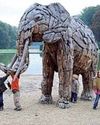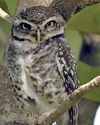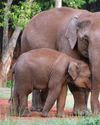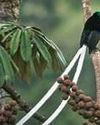The slender, bony-white trunks of dhavda trees, standing out against their dark-barked neighbours, appeared unusually mottled.

As the GPS guided us towards the centre of the survey grid, we found ourselves in the midst of a deafening chorus. The dark mottles on the pale trunks weren’t flakes of the barks, but cicadas. Hundreds of them, all males, buckling and unbuckling their torso muscles to blare out their love songs.
We were on a forest trail in the Bawanthadi forest block in Maharashtra. From predatory robber flies to tigers and leopard scats, there were clear signs that this was a healthy forest, though not a ‘Protected Area’ with a national park or wildlife sanctuary tag. And that was exactly why we were there, with camera traps, mapping devices and other paraphernalia.
The Bawanthadi forest block, spread across the Nagpur and Bhandara Forest Divisions, spans across 600 sq. km. Vast swathes of this deciduous forest harbour a staggering diversity of insects, birds and mammals. But what makes Bawanthadi all-important is its spatial location – the block forms a vital corridor connecting the Pench (across Maharashtra and Madhya Pradesh) and Nagzira-Nawegaon Tiger Reserves. Genetic evidence and photographic records of tiger dispersal across the two tiger reserves have demonstrated that the corridor is functional, making it a high priority site for long-term monitoring and conservation.
THE IMPORTANCE OF FOREST CORRIDORS
هذه القصة مأخوذة من طبعة June 2019 من Sanctuary Asia.
ابدأ النسخة التجريبية المجانية من Magzter GOLD لمدة 7 أيام للوصول إلى آلاف القصص المتميزة المنسقة وأكثر من 9,000 مجلة وصحيفة.
بالفعل مشترك ? تسجيل الدخول
هذه القصة مأخوذة من طبعة June 2019 من Sanctuary Asia.
ابدأ النسخة التجريبية المجانية من Magzter GOLD لمدة 7 أيام للوصول إلى آلاف القصص المتميزة المنسقة وأكثر من 9,000 مجلة وصحيفة.
بالفعل مشترك? تسجيل الدخول

Why Children Are Needed To Help Save The World
On my very first day in India, I encountered many marvelous new customs not practiced in the United States, my home country. But the most curious by far involved trees. Here and there, alongside the roaring streets of Mumbai were rings of marigold wreathed around twisting banyan trunks like dried rays of afternoon sunlight…

Who's Who?
Fact: all toads are frogs, but not all frogs are toads! Let’s unpack this...

The Sea Raptor
The White-bellied Sea Eagle Haliaeetus leucogaster is one of the most common raptors along the Indian coastline. Nevertheless, the sight of this soaring, broad-winged, white and black bird of prey is nothing less than majestic

Bringing Up Bob Hoots.
While we were visiting a friend’s farm in the village of Yelachetty, near Bandipur Tiger Reserve, we found Spotted Owlets nesting on the tiled roof… and one of the chicks on the kitchen floor!

Yala, Land Of The Leopard
Yala is not only Sri Lanka’s second-largest, but also the most-visited national park in the island nation.
The Wizards Of Oz!
Australia is not only a country, but also a continent. The land down under, cut-off from the rest of the world has an abundance of unique species of native animals, birds, reptiles, insects and plants.

Scales & Tails
I was really excited and looking forward to the workshop on reptiles and amphibians at Nature’s Nest in Mollem, Goa, between June 24 and 26, 2017. It was my opportunity to meet renowned herpetologist Varad Giri.

Big, Brilliant And Endangered
When one thinks of elephants, the first word that probably comes to mind is BIG! But elephants, while they may be the largest creatures on land, are not just big and powerful, they’re wise and sensitive as well. Recent scientific studies have established that they are among the most intelligent animals in the world.

Earth Manners
Everyday habits matter! Let’s be kind to the planet, animals and ourselves!

World Scan
CHINA’S IVORY TOWNAn explosive investigation by the Environmental Investigation Agency has revealed how criminal gangs originating from an obscure town in southern China have come to dominate the smuggling of ivory tusks poached from African elephants.